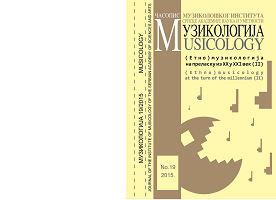Музика, плес и памћење: ка преиспитивању метода теренског истраживања плеса
Music, Dance And Memory. Towards Deliberation of Field Research of Dance
Author(s): Selena RakočevićSubject(s): Theatre, Dance, Performing Arts, Cultural history, Customs / Folklore, Music, Social history, Cultural Anthropology / Ethnology, Culture and social structure , Sociology of Art
Published by: Muzikološki institut SANU
Keywords: Ethnochoreology and ethnomusicology; field exploration; participation; experience; memory;
Summary/Abstract: Although ethnochoreology and ethnomusicology as related academic disciplines have decades-long histories, reviewing and redefining their basic epistemological and methodological principles remained one of the main focuses of disciplinary discussion. Most ethnochoreologists and ethnomusicologist agrees that “field” work (in all its traditional and contemporary forms) remains an essential and constitutive quality of their research and disciplinary fields. The inherent interdisciplinary networking of ethnochoreology and ethnomusicology starts from the theoretical premise that the relationship between the kinetic and musical components of dance is not only unbreakable, but also interactive, and that complex and dynamic manifestations of dance performances represents an expressive medium through which a particular community constructs and represents itself. Since the importance of the individual experience of researchers has been ephasized during the last few decades, a comprehensive method of participant observation remains a central and unifying aspect of fieldwork, both in ethnochoreology and ethnomusicology. Based on field research of musical and dance practices of the village of Svinica (Sviniţa) in Romania, this paper reviews the application and combination of various methods of field research (observation, participation in the performance process, filming, interviews and writing field notes) as the primary tools for the acquisition and shaping of scientific knowledge about dance and music. Issues that will be discussed include the following questions: What are the advantages of personal kinetic/auditory experience during simultaneous perception of dance movement and dance music? How can different methods of field research be combined in order to improve cognitive processes? Are there border areas between ethnochoreological and ethnomusicological fieldwork? Does the variety of methods of field research represents a weakness of the interdisciplinary approach or its advantage? On which information recorded during the fieldwork does a researcher usually build his post-field ethnochoreological/ethnomusical narratives? Through discussion of all these issues, particular emphasis will therefore be placed on the consideration of processes of memorization (visual, auditory and kinetic) when applying the method of participation in the dance performance.
Journal: Muzikologija
- Issue Year: 2/2015
- Issue No: 19
- Page Range: 51-64
- Page Count: 14
- Language: Serbian

